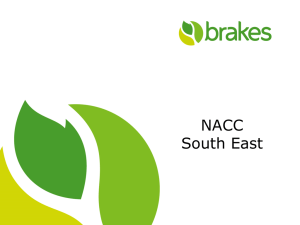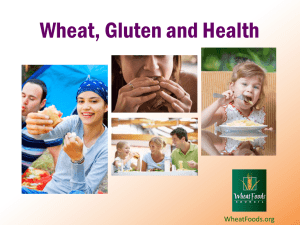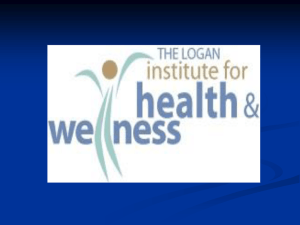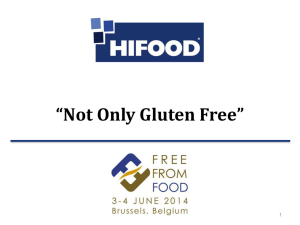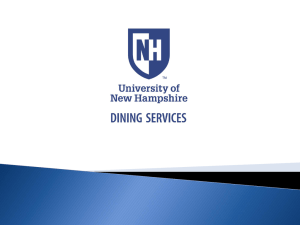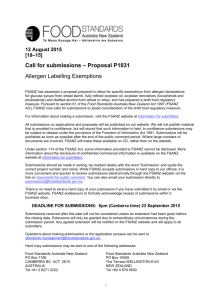Allergies Nutrition Navigation
advertisement
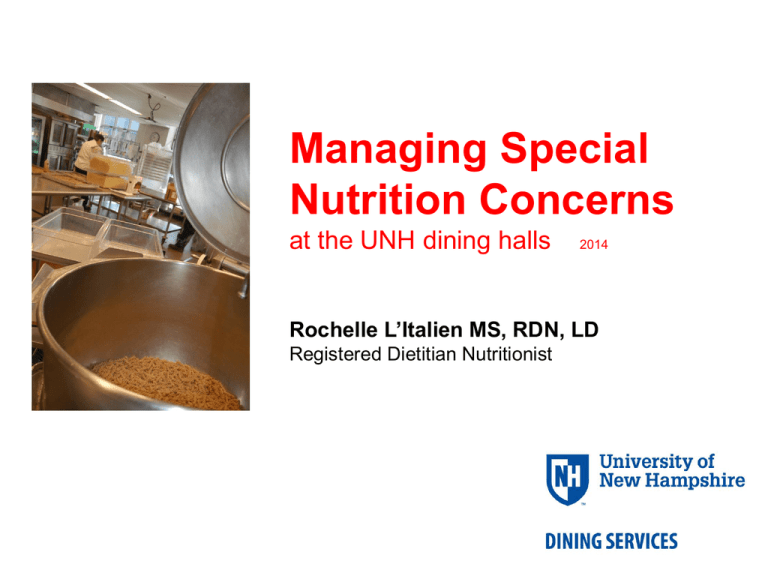
Managing Special Nutrition Concerns at the UNH dining halls 2014 Rochelle L’Italien MS, RDN, LD Registered Dietitian Nutritionist Objectives: 1. Name the 8 most common food allergens. 2. Name the 4 key ingredients to be avoided for gluten-free dining. 3. Name the 6 key methods for preventing cross contact. 4. Understand basics of the Guiding Stars program. 5. Locate nutrition analysis information on our web page menus. FOOD ALLERGIES Food allergy is a serious medical condition affecting up to 15 million people in the United States, including 1 in 13 children. A food allergy results when the immune system in the body mistakenly targets a harmless food protein – an allergen – as a threat and attacks it. Allergy Symptoms (if allergen consumed) Itching in and around the mouth, face, or scalp Tightening in the throat Wheezing or shortness of breath Hives, cramps, vomiting, diarrhea Loss of consciousness and/or death Living with a Food Allergy: Strict avoidance of the offending food. Allergic reaction: CALL 911 CROSS-CONTACT When one food comes into contact with another, causing their proteins/allergens to mix. As a result of cross-contact, each food contains small amounts of the other food that may be invisible to us. Even a trace of an offending food on a spoon or spatula that is invisible to us can cause an allergic reaction. Simply wiping the crumbs from spatulas, cookie sheets, or surfaces is not enough to prevent cross-contact. Use separate, clean utensils, hands and surfaces. Do not handle multiple items (such as items with nuts and items without nuts) without washing hands and utensils in between processes. Garnishes Adding a garnish not called for in a recipe is dangerous, especially using something containing nuts or any of the 8 most common allergens. Ingredient Data Read labels closely for potential allergens or provide the customer with the label to review. Be sure to ask a chef, manager or dietitian if you’re not sure if an item fits under one of the allergen categories. KEY CONCEPT: PROTEIN vs PATHOGEN Area Primary Focus Method All Foods Pathogens Separate, Time/temperature Wash/sanitize Allergens Offending Protein (allergen) Physical avoidance Vegetarian/vegan Contact Physical avoidance Allergen management : A focus on pathogens is not enough. GLUTEN Celiac Disease Need to eat GLUTEN-FREE: Cannot eat wheat, rye, barley Celiac disease requires a lifelong restriction of gluten, which is found in wheat, rye, and barley, and perhaps oats (due to cross contact risk with wheat products). When gluten is consumed the intestines become damaged, causing malabsorption of nutrients needed for good health. With continued exposure further chronic issues can occur. Rice ok, malt NO (contains barley) Fish ok, breading NO (contains wheat) Regular soy sauce NO (most contain wheat) Rice ok, rice pilaf NO (contains orzo pasta) Potatoes and French fries are ok (generally) BUT . . . Cross-contamination with wheat can occur if other breaded items are fried in same oil. And some fries contain wheat in the ingredients; must read all product labels. PB is ok, Jelly is ok, BUT . . . The knife used to spread either one can be cross contaminated with gluten (and peanuts) if used on regular bread. The same goes for a ladle that touches other foods like pasta (wheat). If the sauce was gluten-free before it’s not anymore. . . Toasters cannot be shared. Gluten-free breads need a separate toaster to prevent cross-contamination with gluten. Gluten-free products should not be stored in the same place as regular items – the risk of self-serve cross contamination is too great. Gluten-Containing Foods and Ingredients Atta (chapatti flour) Barley (flakes, flour, pearl) Beer, ale, lager Breading and bread stuffing Brewers yeast Bulgur Communion wafers Couscous Croutons Dinkel (also known as spelt)* Durum* Einkorn* Emmer* Farina Farro or Faro (also known as spelt)* Fu (from wheat; used in some Asian dishes) Graham flour Hydrolyzed wheat protein Kamut* Malt, malt extract, malt syrup and malt flavoring Malt vinegar Malted milk Matzoh, matzoh meal Modified wheat starch Oatmeal, oat bran, oat flour and whole oats** Pastas Rye bread and flour Seitan (from wheat; often in some vegetarian dishes) Semolina Spelt (also known as farro or faro, dinkel)* Triticale Wheat bran Wheat flour Wheat germ Wheat starch *Types of wheat **Unless pure, uncontaminated oats www.glutenfreediet.ca/media/Gluten_Free_Eating_Apr_2011.pdf Some hidden sources of gluten: Beer, ale, lager Broth, soup, soup bases Candies (Smarties® in Canada), some chocolates, some chocolate bars and licorice Flavored coffees and teas Hydrolyzed plant protein and/or hydrolyzed vegetable protein (if from wheat, or the source is not mentioned, are not allowed). Imitation bacon bits and imitation seafoods Medications (check with pharmacist) Modified food starch (if source is not identified) Sausages, hot dogs, deli meats Sauces, marinades, gravies Seasonings Soy sauce Seasoned French Fries Read ingredient labels for potential allergens and/or sources of gluten. GLUTEN – Friendly ZONES For use with only gluten-free foods located at this station. All 3 dining halls; self-serve. What do you do if a customer brings food containing gluten into the gluten-free zone? Kindly inform them that they are at risk of contaminating the area; remove food item immediately. Promptly clean area using designated gluten-free rags and fresh soap/sanitizer. Nutrition Concerns online meal order form available at all 3 dining halls; pre-approval required. http://www.unh.edu/dining/nutrition/concerns.html Separate, dedicated pans and utensils used for allergen-friendly meal orders. Sample online order of a specialized meal: Gluten-Friendly Chicken Parmesan with Rice Pasta. Meal form with time noted when the customer will be in for the meal. Separate, dedicated pans and utensils. Option for separate pan for omelette or stir fry – with allergen-free spray. Summary listing. http://www.unh.edu/dining/nutrition /concerns.html Preventing Cross Contact Wash and rinse hands with warm, soapy water and change gloves before prepping food and in between handling different items. Wash, rinse and sanitize cookware, utensils, and equipment before prepping food. Wiping off surfaces and sanitizers are not enough. For allergen-free items don’t share equipment, surfaces, utensils. Separate: use designated pans, surfaces and utensils for allergen-free items. If asked about an ingredient don’t guess or assume. Contact the kitchen for recipe or product details as needed, get a product label for a customer to read, or ask a supervisor, manager, chef, or the dietitian for assistance. Identify ingredients when asked – mark any with potential allergens. Notify supervisor if there are potential errors on the serving line tags. Read all product ingredient labels and refer to Allergen binder for reference lists. Nutritious choices made simple ™ Guiding Stars® program begins at UNH Dining: 2009 Enhance our current nutritional information offered to guests. Healthy UNH Initiative, goal to be the healthiest campus by 2020. Guiding Stars is Simple Only foods that score above 0 receive stars Good Nutritional Value Better Nutritional Value Best Nutritional Value Guiding Stars Key Features • Highlights foods with higher nutritional density, yet does not “police” less nutritious food choices. • Proprietary algorithm is grounded in evidenced-based science and recommendations of authoritative bodies (FDA, USDA, WHO). Evidence-Based Algorithm (patent pending) The formula credits a product’s score for: The formula debits a product’s score for: vitamins, minerals, dietary fiber, whole grains trans fat, saturated fat, cholesterol, added sodium, added sugars 100 kcal The resulting score represents a weighted total Other Guiding Stars Facts • Four algorithm types to address general, meat/nuts/dairy, baby food and fats/oils • “Living” program… if FDA changes guidelines, Guiding Stars will follow • Seven scientific advisors remain very active in program – meet monthly by phone and twice per year in person • Coffee/Tea/Dried Spices? Contain less than 5 calories per serving and so are not rated. SAMPLE IDENTIFIER TAG Vegetarian/Vegan status and Potential allergen status “Gluten-Friendly” logo Recipe number in FoodPro® Last date nutrition changed in FoodPro® Last date recipe was rated by Guiding Stars ® Alert supervisor if you notice a potential error on a card or if you have any questions about information on the card. (not guaranteed to be gluten-free because of cross-contact risk) Online menus and nutrition data: www.unh.edu/dining Choose a dining hall. Click for menu From here, select a date, meal . . . Nutritive Analysis button Also the ability to set filters for a search. Double click on any recipe description name Nutrition Facts panel, ingredients, and potential allergens. Food Allergy and Gluten Warning: While UNH Dining does not have gluten-free nor allergen-free kitchens and main serving lines, we take every precaution to check ingredient information and to ensure that cross contamination of ingredients does not occur. Ingredients and nutritional content may vary. Manufacturers may change their product formulation or consistency without our knowledge and product availability may fluctuate. While we make every effort to identify nutrition data and allergen information, we cannot assure against these contingencies. It is the responsibility of the customer with food allergies or other specified nutrition concerns to make the final judgment on whether or not to question the ingredients of a food item or to choose to eat the foods selected. Guests are encouraged to consider the information provided, to their own satisfaction, in light of their individual needs and requirements. For individualized assistance please contact a manager on site who can also put you in touch with the Registered Dietitian. Registered Dietitian Nutritionist Rochelle L'Italien, MS, RDN, LD 603.862.2583 rochelle.litalien@unh.edu UNH Mobile App – for UNH Dining: Allergen-Friendly Station at Philbrook Dining Hall: No gluten and none of the 8 top allergens. No food brought on a plate from other food stations – only clean, empty plate. Preventing Cross Contact 1. Wash with warm, soapy water and rinse: hands, equipment, work surfaces, utensils. Do not just wipe a surface or use just sanitizer – allergens can still remain. 2. Don’t handle multiple allergen items at same time. 3. Use designated and separate equipment for allergen-free requests. 4. Label products with correct menu tag; be sure to follow recipes as written. 5. Do not add garnishes or make recipe substitutions. 6. Answer customer questions seriously – do not guess if an ingredient is in a dish or not. Consult the kitchen, chef, manager or dietitian.
